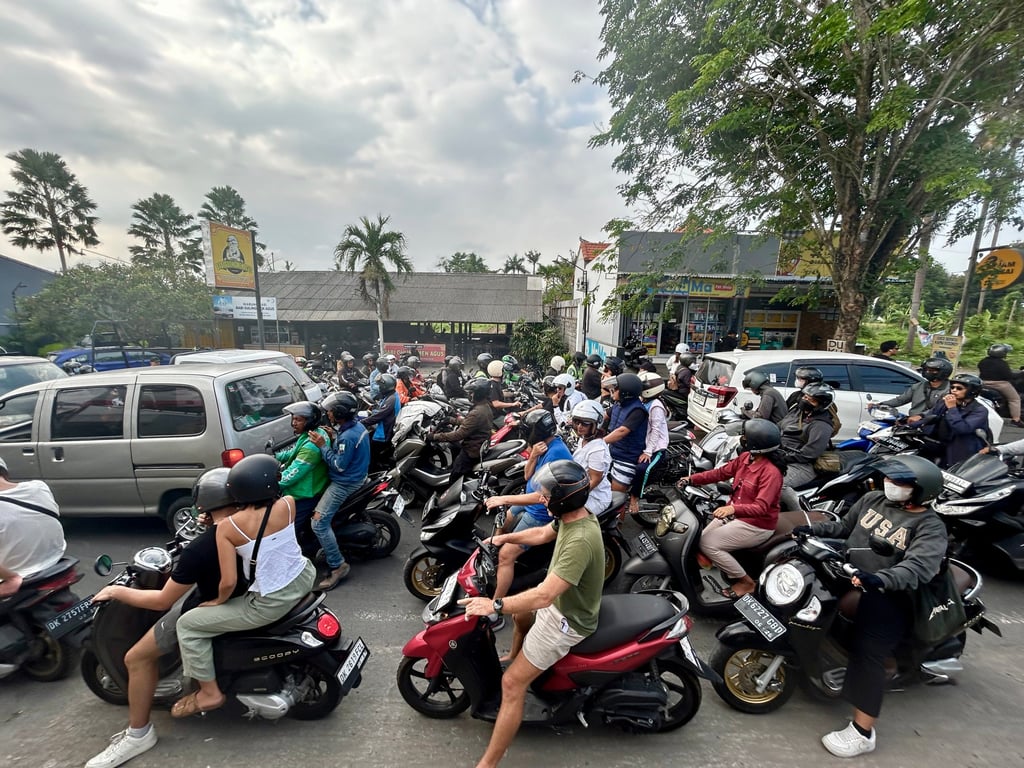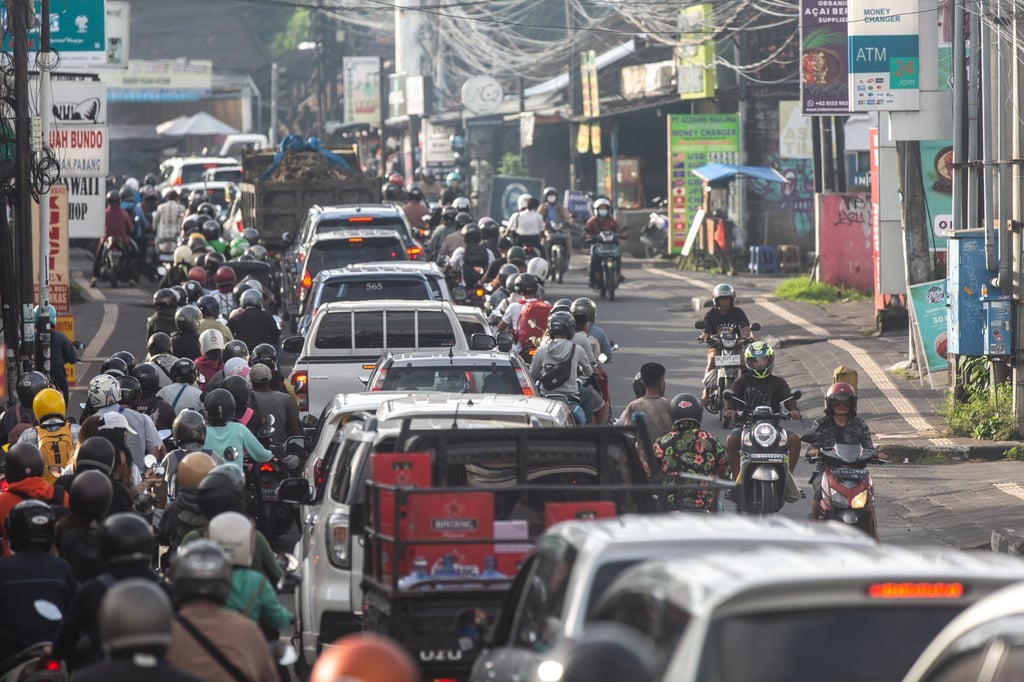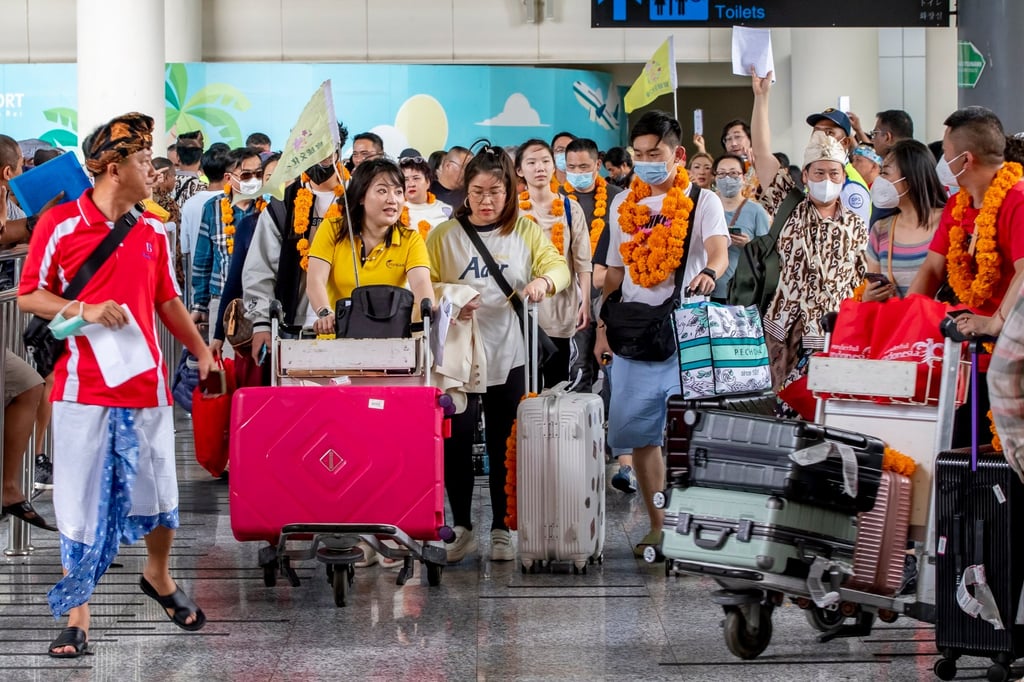Things are even worse in Ubud, the temple town made famous by the 2010 Hollywood blockbuster Eat, Pray, Love, in which actress Julia Roberts was filmed riding a bicycle serenely through emerald green rice fields and along winding country roads.
The reality could hardly be more different: every afternoon the main drag turns into a kilometres-long queue of cars. Most of the town’s hotels have given up offering courtesy buses, while scores of tourists have taken to social media to express their frustration.
“I was here 14 years ago and can’t remember it being so busy and [stressful]. I’m so down … I knew Ubud would be busy but not that busy, especially in April. I am travelling for one month now in Bali and I think it’s almost worse than Canggu,” reads a typical post about Ubud on Reddit.
As a result of the jammed roads, most people on Bali prefer to commute on motorbikes or mopeds, which are rented to tourists without licence checks. Yet this is one of the last places in the world where anyone should ride a motorbike for the first time.
Last year, the Indonesian Transportation Agency recorded 632 people who died due to traffic accidents on the island, 86 per cent of which involved motorbikes. Fatalities are so common, they make the news only when foreigners are involved; most recently in April, when a 22-year-old Belarusian woman was mown down by a bus attempting to overtake her in Bali’s traffic-choked capital, Denpasar.
The cause of Bali’s nightmarish traffic can be lumped into two categories.
The first is the tourism-driven construction boom; hotels with hundreds of rooms and some of the world’s biggest beach clubs are built along roads that are generally not wide enough even to allow cars to pass each other around corners.

What’s more, most developers make only minimal allowances for parking, to increase their profit per square metre of land. Drivers have no option but to park on the shoulder of these narrow roads, creating bottlenecks.
The second cause of Bali’s congestion is the absence of urban planning and chronic underinvestment in roads.
Bali has an annual GDP of nearly US$17 billion, and billions of dollars are collected in taxes and fees every year. But where it goes, nobody knows, although Indonesia is ranked 115th out of 180 countries on Transparency International’s Corruption Perception Index (180 being the most corrupt).
There has been only one major road improvement project in Canggu in the past 12 months: a 400-metre (440-yard) short cut at Tibubeneng Junction built to reduce the permanent queues of vehicles that stretched for kilometres in every direction.
Traffic flow improved marginally as a result, but it just shifted the congestion a little further down the road.
No meaningful public transport exists in Bali. The small number of public buses operating are hot, overcrowded, slow and often driven dangerously. Taxis and ride-hailing apps are the only viable alternative, but introduce even more congestion.

Walking is often not an option. The few footpaths that exist in Bali are nearly all damaged, incomplete and riddled with hazards and chicanes.
In Ubud, illegal stalls set up on footpaths force pedestrians onto the road. And while new footpaths have been built in the centre and on the fringes of Canggu, they are more frequently used by motorbike drivers trying to get around traffic than by pedestrians.
Bicycles? Forget about it.
There is not a single dedicated bicycle lane that I am aware of in Bali and I haven’t dared use my bicycle to commute since the end of the coronavirus pandemic and the return of mass tourism and traffic.
A British friend who recently got into the sport did not last two weeks before his first accident, when he was sideswiped by a motorbike rider, who did not stop to offer assistance.

With the number of visitors to Bali to increase by double digits every year, things are only going to get worse.
The only light at the end of the tunnel is that politicians who once regarded congestion as a positive sign of economic development have finally realised the error of their ways.
“Nowadays the region experiences chronic traffic jams, which could harm Bali’s reputation as an international tourism destination if we do not handle this problem,” Indonesian Transportation Minister Budi Karya Sumadi said in December.
Two months later, Sumadi announced what has been hailed as the first big-ticket solution to Bali’s traffic woes, when he told reporters construction of the long-awaited Bali Light Rail Transit (LRT) was set to commence in September.
The proposed LRT will feature four separate lines with a combined length of 85km (53 miles) connecting the airport with four major tourist towns: Canggu, Ubud, Nusa Dua in the south and Sanur on the east coast. Some of the lines will include underground sections and the estimated cost is US$20 billion.
It is hoped the first two stages, connecting the airport to Canggu and Nusa Dua, will be up and running in 2031, seven years from now.

However, LRTs are notoriously difficult to build. Sydney, Australia’s new light rail network, which is 25km in length, cost more than US$2.1 billion to build.
Putting lines underground is even more costly and complicated. The City and Southwest Metro project in Sydney, which included a tunnel under Sydney Harbour, went more than US$4 billion over budget – and that happened in a place with a long history of delivering infrastructure megaprojects.
Bali, on the other hand, has only ever delivered two mega projects: the 8km Mandara Toll Road from which tourists were forced to walk to the airport in December; and Sunset Road, a 10km-long, eight-lane highway that runs from the airport to the tourist town of Seminyak.
A third mega-project – the 96km Gilimanuk-Mengwi Toll Road, connecting Denpasar to the island’s west coast and ferries to Indonesia’s central island Java – has been on hold for more than two years after the original investor failed to secure funding.
Meanwhile, the even longer-awaited North Bali International Airport has been removed from Indonesia’s list of national strategic projects because of a lack of progress.
Bali’s proposed LRT network is doubtless a step in the right direction. Now the authorities have to show they have the wherewithal to deliver it.







